It’s a Cascade of 14nm CPUs: AnandTech’s Intel Core i9-10980XE Review
by Dr. Ian Cutress on November 25, 2019 9:00 AM ESTCPU Performance: Encoding Tests
With the rise of streaming, vlogs, and video content as a whole, encoding and transcoding tests are becoming ever more important. Not only are more home users and gamers needing to convert video files into something more manageable, for streaming or archival purposes, but the servers that manage the output also manage around data and log files with compression and decompression. Our encoding tasks are focused around these important scenarios, with input from the community for the best implementation of real-world testing.
All of our benchmark results can also be found in our benchmark engine, Bench.
Handbrake 1.1.0: Streaming and Archival Video Transcoding
A popular open source tool, Handbrake is the anything-to-anything video conversion software that a number of people use as a reference point. The danger is always on version numbers and optimization, for example the latest versions of the software can take advantage of AVX-512 and OpenCL to accelerate certain types of transcoding and algorithms. The version we use here is a pure CPU play, with common transcoding variations.
We have split Handbrake up into several tests, using a Logitech C920 1080p60 native webcam recording (essentially a streamer recording), and convert them into two types of streaming formats and one for archival. The output settings used are:
- 720p60 at 6000 kbps constant bit rate, fast setting, high profile
- 1080p60 at 3500 kbps constant bit rate, faster setting, main profile
- 1080p60 HEVC at 3500 kbps variable bit rate, fast setting, main profile
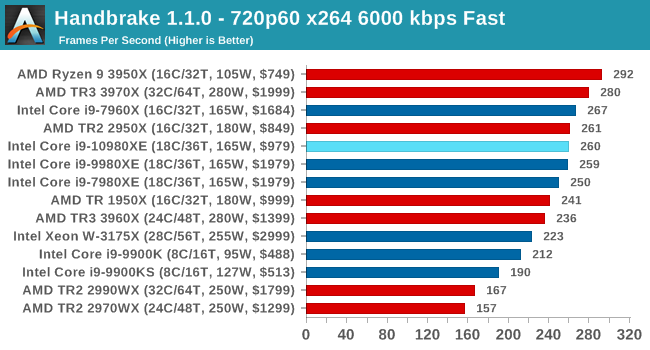
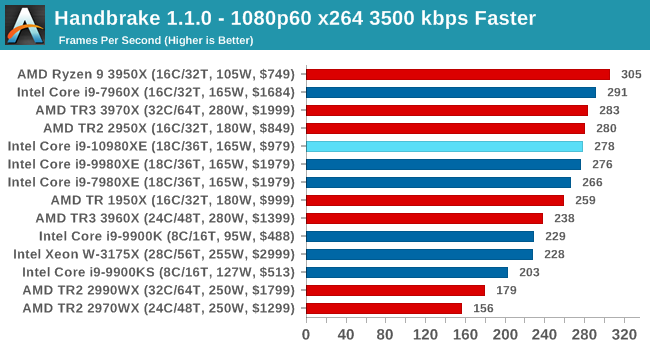
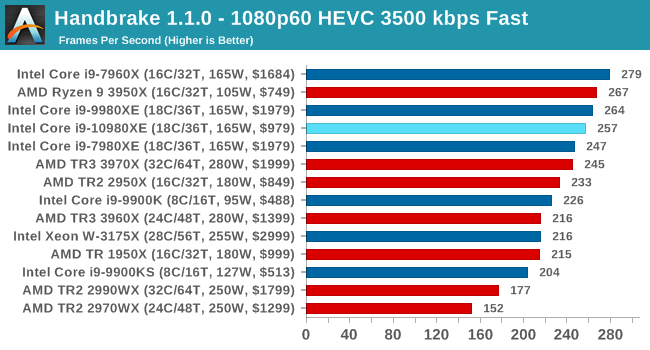
7-zip v1805: Popular Open-Source Encoding Engine
Out of our compression/decompression tool tests, 7-zip is the most requested and comes with a built-in benchmark. For our test suite, we’ve pulled the latest version of the software and we run the benchmark from the command line, reporting the compression, decompression, and a combined score.
It is noted in this benchmark that the latest multi-die processors have very bi-modal performance between compression and decompression, performing well in one and badly in the other. There are also discussions around how the Windows Scheduler is implementing every thread. As we get more results, it will be interesting to see how this plays out.
Please note, if you plan to share out the Compression graph, please include the Decompression one. Otherwise you’re only presenting half a picture.
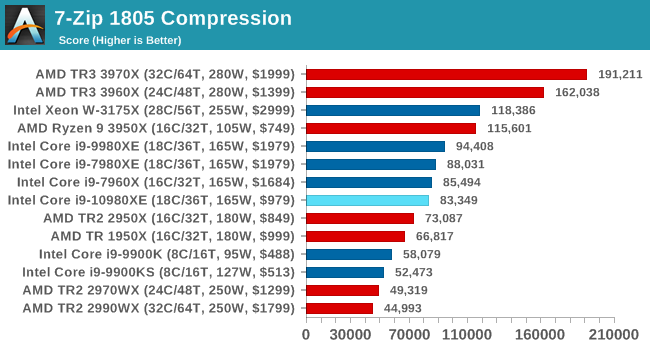
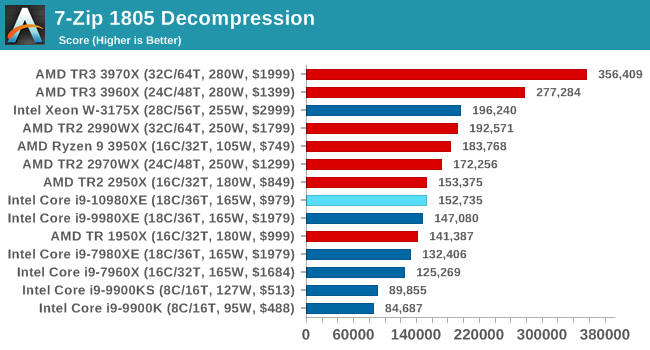
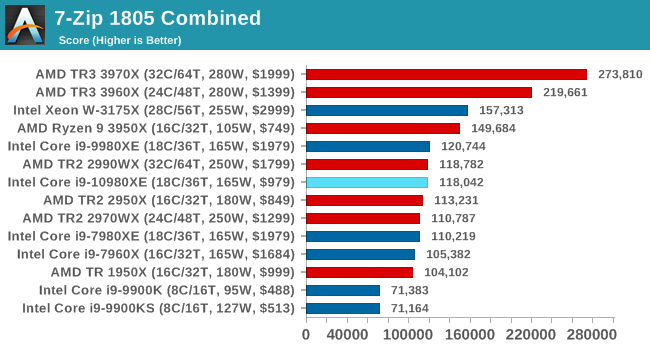
WinRAR 5.60b3: Archiving Tool
My compression tool of choice is often WinRAR, having been one of the first tools a number of my generation used over two decades ago. The interface has not changed much, although the integration with Windows right click commands is always a plus. It has no in-built test, so we run a compression over a set directory containing over thirty 60-second video files and 2000 small web-based files at a normal compression rate.
WinRAR is variable threaded but also susceptible to caching, so in our test we run it 10 times and take the average of the last five, leaving the test purely for raw CPU compute performance.
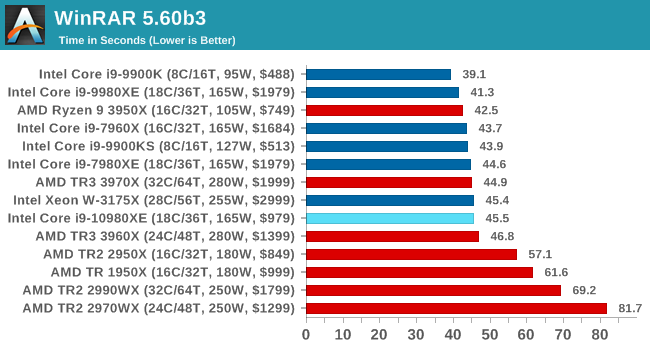
AES Encryption: File Security
A number of platforms, particularly mobile devices, are now offering encryption by default with file systems in order to protect the contents. Windows based devices have these options as well, often applied by BitLocker or third-party software. In our AES encryption test, we used the discontinued TrueCrypt for its built-in benchmark, which tests several encryption algorithms directly in memory.
The data we take for this test is the combined AES encrypt/decrypt performance, measured in gigabytes per second. The software does use AES commands for processors that offer hardware selection, however not AVX-512.
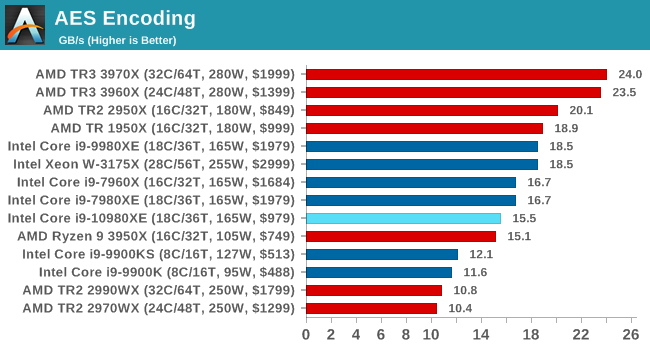
More than a slight regression here in our AES testing - this is probably the most severe of all our tests for how the security fixes have affected performance.










79 Comments
View All Comments
Korguz - Thursday, November 28, 2019 - link
yep.. i knew gondalf wouldnt answer my question...0ldman79 - Thursday, December 5, 2019 - link
That is ignorant.Adding L3 cannot increase processing. The L3 can only improve feeding of data, further the L3 is a victim cache, the data has to be expelled from the L2 first.
It doesn't matter how big the fuel line is on your 4 cylinder, it's only going to burn so much gas. Same for the L2 and L3. If the size of the cache increases the IPC that is *only* because the cache was too small for the design in the first place.
Korguz - Sunday, December 8, 2019 - link
keep in mind, the comment is from gondalf, he will say any thing to make his beloved intel look better, as you can see, he DIDN'T answer my question to him as well...airdrifting - Monday, November 25, 2019 - link
You are delusional. 2011 is the year for 2500K/2600K release, and since then Intel has been charging 300+ for quad core till 2017 Ryzen release. It was also the six darkest years in CPU history where we see like 5% increase in IPC every year, I kept my 4.5GHz overclocked 2600K for 6 years because there was no reason to upgrade.eek2121 - Monday, November 25, 2019 - link
Yeah that was part of the issue. Sandy Bridge had so much overclocking headroom, you could put a good AiO on it, crank it up to 4.8-5.0 GHz, and generations later the competition would just barely catch up. The percentage of difference between the two was very small, and Bulldozer was chasing Core i3s.rahvin - Monday, November 25, 2019 - link
You're not alone buddy. I've held on to my Icy Bridge 3700K until Ryzen 39**X because Intel was offering no innnovation to the market.I distinctly remember the Anandtech article for IIRC the Kaby Lake Intel processors where they basically said this was the first generation to be 20% better than Sandy Bridge/Icy Bridge which made is worth upgrading. That was 6 years without any performance increases.
Make no mistake, without AMD competition we wouldn't have moved beyond 8 cores on the desktop or 12 cores in the HEDT. Intel was happy to sit on their fingers and rake in the money with 2-5% improvement per year. In fact 3 solid years of AMD competition have doubled core counts on both the desktop and server and at the same time lowered prices across the board. Without AMD there is no innovation at Intel because they don't have competition. Thank god for Lisa Su.
Santoval - Monday, November 25, 2019 - link
Bollocks. Pulling arbitrary dollar values of nameless CPUs out of your behinds and linking even more arbitrarily 2011 CPUs to 2019 CPUs is an extremely poor tactic. Your suck at this (-->Intel apologetics). Be better so we can have meaningful arguments :)milkywayer - Monday, November 25, 2019 - link
Read the article your posting spam at. The author mentions the 1900 and 900 numbers. I'll let you guess which page. You might actual read the review then.milkywayer - Monday, November 25, 2019 - link
Whups. Meant it for RegsEx.milkywayer - Monday, November 25, 2019 - link
Out of the kindness of their heart. How generous and kind of them./s